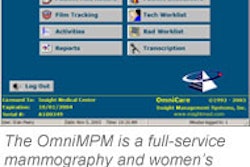A RIS cannot be an isolated, standalone product. It must have the capability to integrate with a multitude of healthcare informatics systems, according to RIS expert Rex Osborn.
"A RIS is no longer an island of information," said Osborn, a consultant with First Consulting Group of Long Beach, CA. "Because RIS is now part of an enterprise, we have to start looking at the features and functionality and think: Are we looking toward the future of what the requirements will be for our technology as other departments start attenuating the strength of radiology?"
These other systems include:
- Clinical data repository (CDR)
- Electronic health record (EHR)
- Clinical information system (CIS)
- Financial system
- Point-of-care network such as a computerized physician order entry (CPOE) system
- PACS
- Voice recognition or digital dictation system
Osborn offered his insights on the new wave of RIS with attendees at the 2004 American Healthcare Radiology Administrators (AHRA) meeting in Boston.
Features and functions
In the past few years, vendors have sought to meet the growing demands for RIS data outside the radiology department by adding new features and functionalities.
Web functionality for remote access to RIS functions has been incorporated to enable physicians outside radiology to retrieve information. Web access is accomplished through a secure portal, and includes remote access to scheduling for referring physicians, Osborn said.
Web distribution for reference images and related data is another option available in some RIS products. This allows access to application service provider (ASP)-based image management systems or PACS options, he said.
The utilization review management reporting feature allows reporting on radiology resources to indicate cost and investment of time and technical expertise. "This feature can provide administrators with a more comprehensive view of what the radiology group is doing," Osborn said.
The virtual master jacket is a feature that allows multiple master film folder volumes and its subsequent subfolders to be incorporated into one virtual folder, permitting the tracking of hard-copy films as well as soft-copy images, including CDs or DVDs. "It gives us the capacity to have an audit trail of where exactly we are distributing some information," he said.
Integration with a CDR on an enterprise-wide basis is another capability of some new RIS products. This allows the computerized data record to have radiology information integrated and available via an HL7 interface, Osborn said.
Seamless integration with PACS and image management systems is a capability many RIS vendors are now offering. "This functionality allows image distribution with integrated demographic and clinical relational data, such as the diagnostic report, patient information, and image information," he said.
User configuration tools that include export and import functions for implementation help simplify the conversion from an existing RIS. This feature provides users the option to create simple datasets for an existing system to be loaded onto a preset or assigned spreadsheet.
"The spreadsheet can be downloaded into existing dictionaries, thereby requiring a limited-access build for clients with existing history, patient, and diagnostic report files," Osborn said.
Mammography modules have also been added to many commercially available RIS products. They allow the support of a mammography-centric application that meets regional regulations for reporting and statistic gathering, he said. Mammography modules can include the capability for patient follow-up, Mammography Quality Standards Act (MQSA) compliance, and meeting BI-RADS requirements.
A patient-tracking feature has found its way into many current RIS applications. It allows a radiology manager, or other interested parties within the department, to peruse real-time tracking of patients from the time the patient arrives and has an exam to the time the patient is discharged, Osborn said. The feature permits system updates by personnel, such as admitting and technologists, as they interact with the patient during the procedure.
Some RIS vendors are now adding the capability to include multimedia links for image and Web-based information.
"This allows the user to link to appropriate URLs for education and additional clinical information, as well as business-to-consumer services and future applications," Osborn said. "Image management systems can also be added or embedded to allow easy integrated access."
Lastly, Osborn mentioned that he has seen some RIS products that offer a more detailed technologist-completion feature. This allows the technologist to enter all information that is relative to the performed procedure. For example, if additional views are taken, additional relative charges can be added on the fly so that when the exam is completed, the appropriate technical charges can be added, he said.
"It wasn't even three years ago when you didn't even hear about RIS," Osborn said. "It was all about PACS. Well, PACS is a glorified lightbox without something leading and guiding it and bringing a conduit of information into it. Integration of the two systems is key; having a RIS feed information to a PACS empowers it."
By Jonathan S. Batchelor
AuntMinnie.com staff writer
October 8, 2004
Related Reading
European HIS market set to double in seven years, August 19, 2004
Pre-PACS assessment gives an edge in installation, August 4, 2004
Optimizing alternative reporting strategies, July 16, 2004
Centralized scheduling brings efficiency, convenience, June 25, 2004
RIS and PACS -- together at last, June 11, 2004
Copyright © 2004 AuntMinnie.com



















